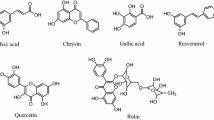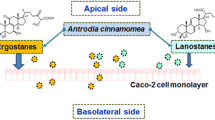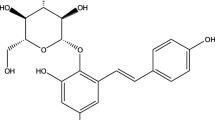Abstract
Purpose: Tea flavonoids, including (–)-epicatechin (EC), have been suggested to have chemopreventive properties in cancer. However, there is limited knowledge of the oral bioavailability of these dietary compounds. The purpose of this study was to gain a better understanding of the absorption of EC.
Methods: The intestinal epithelial membrane transport of EC was examined using the monolayer of the human Caco-2 cell line grown in Transwells, a common model of intestinal absorption. EC and its metabolites were measured by high performance liquid chromatography with diode array detection.
Results: EC showed no apical to basolateral absorption at concentrations ranging from 5 to 50 μM. In contrast, EC demonstrated basolateral to apical efflux with a P app value of 0.67 ± 0.05 × 10−6 cm/sec, i.e., slightly higher than for mannitol, 0.50 ± 0.30 × 10−6 cm/sec, a paracellular transport marker. There was a 50% reduction in the efflux of EC in the presence of 50 μM MK-571, a competitive inhibitor of the MRP2 transporter expressed in the apical membrane of Caco-2 cells. Most important, the presence of 50 μM MK-571 resulted in clearly measurable apical to basolateral absorption of EC with a P app of 0.31 ± 0.06 × 10−6 cm/sec. Two polar metabolites, M1 and M2, were formed from EC, both of which appeared exclusively on the apical side. MK-571 (50 μM) dramatically inhibited the transport for both of these metabolites. Incubations with inorganic 35SO4 2− and hydrolysis by aryl sulfatase strongly suggested that these metabolites were sulfate conjugates.
Conclusions: These results suggest an important role for the multispecific organic anion transporter MRP2 in the bioavailability of EC and possibly other tea flavonoids.
Similar content being viewed by others
REFERENCES
M. G. L. Hertog, P. C. H. Hollman, and M. B. Katan. Content of potentially anticarcinogenic flavonoids of 28 vegetables and 9 fruits commonly consumed in the Netherlands. J. Agric. Food Chem. 40:2379-2383 (1992).
M. G. L. Hertog, P. C. H. Hollman, and B. van de Putte. Content of potentially anticarcinogenic flavonoids of tea infusions, wines and fruit juices. J. Agric. Food Chem. 41:1242-1246 (1993).
I. C. Arts, B. van De Putte, and P. C. Hollman. Catechin contents of foods commonly consumed in the Netherlands. 2. Tea, wine, fruit juices, and chocolate milk. J. Agric. Food Chem. 48:1752-7. (2000).
C. S. Yang and Z. Y. Wang. Tea and cancer. J. Natl. Cancer Inst. 85:1038-49. (1993).
R. W. Teel and H. Huynh. Effect of phytochemicals on CYP 450 linked alkoxyresorufin O-dealkylase activity. Phyto. Res. 12:89-93 (1998).
S. K. Katiyar and H. Mukhtar. Tea in chemoprevention of cancer. Int. J. Oncol. 7:133-141 (1996).
Y. L. Lin and J. K. Lin. (−)-Epigallocatechin-3-gallate blocks the induction of nitric oxide synthase by down-regulating lipopolysaccharide-induced activity of transcription factor nuclear factor-kappaB. Mol. Pharmacol. 52:465-472. (1997).
Z. Dong, W. Ma, C. Huang, and C. S. Yang. Inhibition of tumor promoter-induced activator protein 1 activation and cell transformation by tea polyphenols, (−)-epigallocatechin gallate, and theaflavins. Cancer Res. 57:4414-4419. (1997).
M. J. Lee, Z. Y. Wang, H. Li, L. Chen, Y. Sun, S. Gobbo, D. A. Balentine, and C. S. Yang. Analysis of plasma and urinary tea polyphenols in human subjects. Cancer Epidemiol. Biomarkers Prev. 4:393-399. (1995).
C. S. Yang, L. Chen, M. J. Lee, D. A. Balentine, M. C. Kuo, and S. P. Schantz. Blood and urine level of tea catechin after ingestion of different amounts of green tea by human volunteers. Cancer Epidemiol. Biomarkers Prev. 7:351-354 (1998).
S. Baba, N. Osakabe, A. Yasuda, M. Natsume, T. Takizawa, T. Nakamura, and J. Terao. Bioavailability of (−)-epicatechin upon intake of chocolate and cocoa in human volunteers. Free Rad. Res. 33:635-641 (2000).
H. H. S. Chow, Y. Cai, D. S. Alberts, I. Hakim, R. Dorr, F. Shahi, J. A. Crowell, C. S. Yang, and Y. Hara. Phase I pharmacokinetic study of tea polyphenols following single-dose administration of epigallocatechin gallate and polyphenon E. Cancer Epidemiol. Biomark. Prev. 10:53-58 (2001).
H. Lennernas. Human jejunal effective permeability and its correlation with preclinical drug absorption models. J. Pharm. Pharmacol. 49:627-38 (1997).
P. Artursson. Epithelial transport of drugs in cell culture. I: A model for studying the passive diffusion of drugs over intestinal absorptive (Caco-2) cells. J. Pharm. Sci. 79:476-482 (1990).
S. Yee. In vivo permeability across Caco-2 cells can predict in vivo (small absorption) in man-fact or myth. Pharm. Res. 14:763-766 (1997).
P. Artursson and J. Karlsson. Correlation between oral drug absorption in humans and apparent drug permeability coefficients in human intestinal epithelial (Caco-2) cells. Biochem. Biophys. Res. Commun. 175:880-885 (1991).
R. A. Walgren, U. K. Walle, and T. Walle. Transport of quercetin and its glucosides across human intestinal epithelial Caco-2 cells. Biochem. Pharmacol. 55:1721-1727 (1998).
U. K. Walle, A. Galijatovic, and T. Walle. Transport of the flavonoid chrysin and its conjugated metabolites by the human intestinal cell line Caco-2. Biochem. Pharmacol. 58:431-438 (1999).
I. Leier, G. Jedlitschky, U. Buchholz, S. P. C. Cole, R. G. Deeley, and D. Keppler. The MRP gene encodes an ATP-dependent export pump for leukotriene C4 and structurally related conjugates. J. Biol. Chem. 269:27807-27810 (1994).
G. Jedlitschky, I. Leier, and U. Buchholz. ATP-dependent tranport of glutathine S-conjugates by the multidrug resistance-associated protein. Cancer Res. 54:4833-4836 (1994).
T. Tsuruo, H. Iida, S. Tsukagoshi, and Y. Sakurai. Overcoming of vincristine resistance in P388 leukemia in vivo and in vitro through enhanced cytotoxicity of vincristine and vinblastine by verapamil. Cancer Res. 41:1967-1972 (1981).
F. J. Sharom. The P-glycoprotein efflux pump: How does it trasport drugs? J. Membr. Biol. 160:161-175 (1997).
Q. Y. Zhu, A. Zhang, D. Tsang, Y. Huang, and Z. Chen. Stability of green tea catechins. J. Agric. Food Chem. 45:4624-4628 (1997).
A. Galijatovic, Y. Otake, U. K. Walle, and T. Walle. Extensive metabolism of the flavonoid chrysin by human Caco-2 and Hep G2 cells. Xenobiotica 29:1241-1256 (1999).
T. Walle, U. K. Walle, K. R. Thornburg, and K. L. Schey. Stereoselective sulfation of albuterol in humans: biosynthesis of the sulfate conjugate by Hep G2 cells. Drug Metab. Dispos. 21:76-80 (1993).
J. Hunter, M. A. Jepson, T. Tsuruo, N. L. Simmons, and B. H. Hirst. Functional expression of P-glycoprotein in apical membranes of human intestinal Caco-2 cells — kinetics of vinblastine secretion and interaction with modulators. J. Biol. Chem. 268:14991-14997 (1993).
U. K. Walle and T. Walle. Taxol transport by human intestinal epithelial Caco-2 cells. Drug Metab. Dispos. 26:343-346 (1998).
R. A. Walgren, K. J. Karnaky, Jr., G. E. Lindenmayer, and T. Walle. Efflux of dietary flavonoid quercetin 4′-β-glucoside across human intestinal Caco-2 cell monolayers by apical multidrug resistance-associated protein-2. J. Pharmacol. Exp. Ther. 294:830-836 (2000).
D. W. Loe, R. G. Deeley, and S. P. C. Cole. Characterization of vincristine transport by the Mr 190,000 multidrug resistance protein (MRP): Evidence for cotransport with reduced glutathione. Cancer Res. 58:5130-5136 (1998).
K. Okushio, M. Suzuki, N. Matsumoto, F. Nanjo, and Y. Hara. Identification of (−)-epicatechin metabolites and their metabolic fate in the rat. Drug Metab. Dispos. 27:309-316 (1999).
J. König, A. T. Nies, Y. Cui, I. Leier, and D. Keppler. Conjugate export pumps of the multidrug resistance protein (MRP) family: localization, substrate specificity, and MRP2-mediated drug resistance. Biochim. Biophys. Acta 1461:377-394 (1999).
Author information
Authors and Affiliations
Rights and permissions
About this article
Cite this article
Vaidyanathan, J.B., Walle, T. Transport and Metabolism of the Tea Flavonoid (–)-Epicatechin by the Human Intestinal Cell Line Caco-2. Pharm Res 18, 1420–1425 (2001). https://doi.org/10.1023/A:1012200805593
Issue Date:
DOI: https://doi.org/10.1023/A:1012200805593




